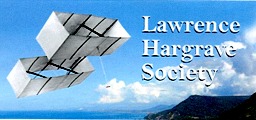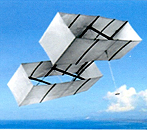A BRIEF FLIRTATION WITH GLIDING - 1894
Hargrave was becoming well known and respected overseas, in the USA and UK. In 1891 he donated several of his models to the now Powerhouse Museum in Sydney. His father and brother Ralph has both died by this time, leaving Lawrence a small fortune, enough to finance a decade of intensive aeronautical research. The Depression of the 1890s, perhaps the worst in Australia’s history, cut deep into savings and prompted a family relocation to the quiet seaside valley of Stanwell Park, some 35 miles south of Sydney. His brother Ralph had built a fine bungalow there just before he was killed in Hong Kong in 1888. The Hargraves, with five children and staff, moved there in 1893, staying for six years of peaceful but productive research.
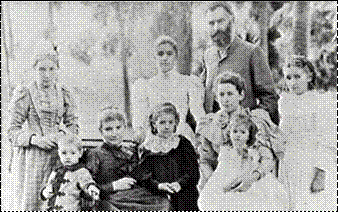 The Hargrave household at Stanwell Park, 1894. Left to right: Susan Shepherd, maid; Geoffrey; Mrs. Margaret Hargrave; Margaret (Maggie); Helen (Nellie) standing beside Lawrence; Miss Gibson, governess, with Brenda Olive; and Hilda.
The Hargrave household at Stanwell Park, 1894. Left to right: Susan Shepherd, maid; Geoffrey; Mrs. Margaret Hargrave; Margaret (Maggie); Helen (Nellie) standing beside Lawrence; Miss Gibson, governess, with Brenda Olive; and Hilda.
It was not at first sight the place most would choose to develop a manned aircraft, being a small valley by the sea with no flat ‘runway’ to speak of. But it had wind, funneling up the coastal escarpment, and making Stanwell Park ideal for hang gliding today. Hargrave was to harness this wind in spectacular ways during his time there.
In the 1890s aeronautical pioneers were limited by the lack of suitable power to propel aircraft capable of carrying people. Aeronautical pioneers turned to gliding. They worked on the best wing designs for manned flight. Perhaps the most famous experimenter with gliders at the time was Otto Lilienthal, enthusing Hargrave into trying one of his own, using the sand hill at Stanwell Park. He built a tandem monoplane. His wife Margaret was caught up in the excitement of an actual flying machine, sewing the wings for the glider. On 25 June the maiden flight from the sand dune caused some anxious moments as the ‘machine turned up and set me on my back’.
Hargrave’s sketch in his journal:
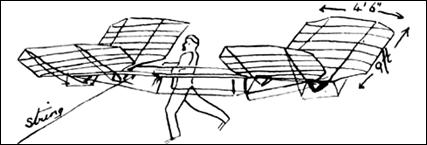 As he reported to the Royal Society:
As he reported to the Royal Society:
‘The writer put together and made several jumps with a trussed affair having four wings eight feet by four feet nine inches, equal to a total area of one hundred and fifty two square feet of arched surface; it weighed under twenty five pounds. This line of experiment was discontinued as it was seen that an accident might readily occur without making any real progress with the flying machine.’
So ended the first hang glider to be built at Stanwell Park, now internationally famous for this sport because of its prevailing winds and high overhanging hill, Bald Hill. Hargrave discontinued this line of experimentation for fear of a serious accident, preferring the stability of his multi-surface (box) kites. Hargrave next developed his ideas on safe wing surfaces, utilizing the winds of Stanwell Park in the best known of his achievements, ascent into the air supported by cellular or box kites.
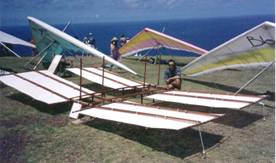
Rob De Groot with his replica of the Hargrave Glider at the Hang Gliding World Championships in 1994, Bald Hill, Stanwell Park.
